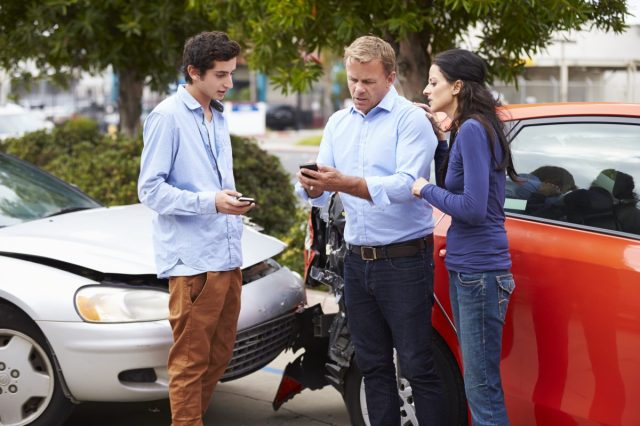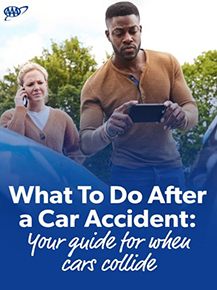Getting into a car crash isn’t something we plan on. It’s a scenario we’d generally like to avoid. But when it does happen, how do insurance companies determine fault?
Unless the crash you were involved in can be considered no-doubt liability, such as rear-end or left-turn collisions, there will likely be a process you and your insurance company go through to determine who exactly is at fault. We asked a AAA insurance expert how it works.
Contributary vs. Comparative Laws
“There are different state laws that regulate fault, how it’s determined and even whether you can collect from the other party or not,” said Gregory Smolan, AAA Northeast’s vice president of insurance operations.
Whether or not you can collect payment after an accident depends on if you live in a contributary state or a comparative state. Living in a contributary state means that if you’re found to be even a small amount at fault, you can’t collect from the other driver. In comparative states, compensation is awarded based on your determined percentage of fault.
This map shows contributary and comparative negligence laws by state.
In the Northeast, states like Massachusetts, New Jersey and New York have no-fault insurance, which are laws that require each driver injured in an accident to file a claim with their own insurance company, so that each person is compensated for their medical bills, regardless of who was at fault.
Determining Fault After a Car Crash
“Typically, when a collision happens, the first line of defense is self-reporting,” Smolan advised. There are many times the police are called, and they’ll do an accident report that then goes to the adjuster. Usually, the way the report is written will give you a determination of who was probably in the wrong.”
In many cases, bystanders have a part to play in determining who’s ultimately at fault. “If I’m an adjuster,” Smolan said, “I’ll look at the police report, take statements from our driver and get their version of events. If there are any witnesses, I’d even call them for a statement. But we also have traffic cams now.”
Speaking of cameras, how about dash cams? Are they a hindrance to the fault process, or do they help? Smolan said they’re a great tool to have in your arsenal in the event of an crash. “Certainly, if you’re in a collision and you’re trying to determine fault, a dash cam is video proof just like a traffic cam. It’s totally valid.”
Do you have usage-based insurance? Even better. “Some folks have UBI, so they’re tracking their driving habits on their phones. If you can go back and see proof in those stats, they can help disprove someone else’s accusation.”
Essentially, if you’re trying to build a case, accumulating proof with photos, witnesses and the police report are your best bet. “You may still technically be at fault,” said Smolan. “But at least you’ve produced as much evidence as you can to the contrary.”

Once all the information about the accident has been received and the insurance companies begin their investigation, each will submit a determination of fault percentages. Surprisingly, these percentages aren’t precise and are only an estimate. “There’s no mathematical equation,” Smolan said. A lot of what ultimately determines fault is good old negotiation with the other party. If there is a disagreement with the results and both parties can’t come to an agreement, the situation will be handled by an arbitrator who’ll review all the facts and make a final decision.
If you find yourself in a scenario where the other party involved in the accident doesn’t have insurance, not all is lost. “Check with your own carrier about your uninsured motorist or under-insured motorist coverage to see if you have coverage on your policy,” Smolan said.
Top Takeaways
- First and foremost, make sure nobody’s injured and that your vehicles are in a safe spot before starting the claims process.
- Take pictures of damage and the location.
- Exchange information with the other party and contact your insurance company right away.
- If there are bystanders, get their names and numbers.
- If there is any damage, get the police there to submit a report.
- Don’t admit fault at the scene. “It’s not up to you to determine fault or admit fault at the site,” said Smolan. “Let the process play out.”
Find Out More About AAA Auto Insurance
This article has been updated and republished from a previous version.
4 Thoughts on “How Do Insurance Companies Determine Fault?”
Leave A Comment
Comments are subject to moderation and may or may not be published at the editor’s discretion. Only comments that are relevant to the article and add value to the Your AAA community will be considered. Comments may be edited for clarity and length.















A person lost control of their vehicle in Queens, NY as she raced toward my vehicle. The person moved their vehicle back onto the service road and opened their door leaving the car in a dangerous position. I immediately contacted the police and they arrived in seconds. The police instructed the person to climb over the center consol as she requested an ambulance. The police asked about the minor one inch scratch on my vehicle. Aparently, she brushed my vehicle in the rear quarter. They told me it was nothing and I could leave. A touch up brush was all I needed. I was contacted by Travelers; It was a lawsuit. I picked up the police report and it was totally bogus. It claimed I lost control and also hit a tree. Travelers sent a representative to take picutures and I had to point out where the scratch was. This person was paid $10,000. Travelers said it was easier to pay then be harassed every day with phone calls. Then, they increased my insurance. I no longer have Travelers and no longer visit Queens, NY.
When I was biking, I was hit by a car. I was going straight in the intersection, and the car was turning left. I had a right of way in the intersection, and apparently, the driver didn’t see the oncoming traffic. I broke my wrist and my bike’s brake lever broke. However, the insurance company (MetLife) said that I was responsible for the accident. I checked the traffic law, and I wrote back with the supporting section of the law insisting that the driver was responsible. They ignored my letter for a while, so I pinged them. They still said I was responsible. I wrote back several times, but they were persistent. More than a year had passed when I finally hired a lawyer who specialized in bike accidents. When I met him, he said the driver was clearly responsible. He wrote a letter to MetLife. The letter said basically the exact same thing that I had insisted, but this time it had a lawyers name and signature at the bottom. Within a month, MetLife accepted the driver’s responsibility. I asked my lawyer why a big company like MetLife cheats. He said that’s why we have so many law suits in this country.
good for you for persisting. Even though they are “climate champions” bicyclists are often disrespected by motorists, police, and evidently, insurers.
That is horrendous. Thank you for sharing this.